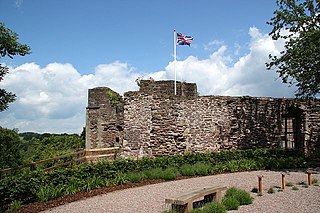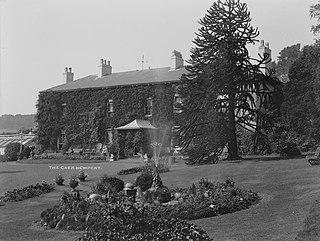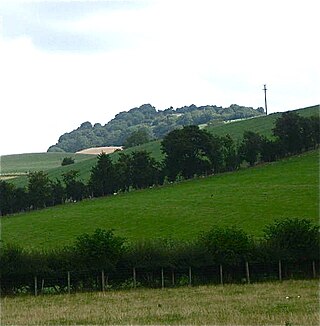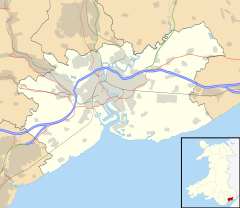
Caerleon is a town and community in Newport, Wales. Situated on the River Usk, it lies 5 miles (8 km) northeast of Newport city centre, and 5.5 miles (9 km) southeast of Cwmbran. Caerleon is of archaeological importance, being the site of a notable Roman legionary fortress, Isca Augusta, and an Iron Age hillfort. Close to the remains of Isca Augusta are the National Roman Legion Museum and the Roman Baths Museum. The town also has strong historical and literary associations: Geoffrey of Monmouth elevated the significance of Caerleon as a major centre of British history in his Historia Regum Britanniae, and Alfred Lord Tennyson wrote Idylls of the King (1859–1885) while staying in Caerleon.

Newport is a town, community, electoral ward and ancient port of Parrog, on the Pembrokeshire coast in West Wales at the mouth of the River Nevern in the Pembrokeshire Coast National Park.

Swansea Castle is located in the city centre of Swansea, Wales, UK. It was founded by Henry de Beaumont in 1107 as the caput of the lordship of Gower. The castle is now ruined and only two blocks remain, though the site has been improved in the 2010s for use as a public space.

Abergwyngregyn is a village and community of historical note in Gwynedd, a county and principal area in Wales. Under its historic name of Aber Garth Celyn it was the seat of Llywelyn ap Gruffudd. It lies in the historic county of Caernarfonshire.

Baglan is a village in Wales, adjoining Port Talbot, named after Saint Baglan. It is also a community and ward in the Neath Port Talbot county borough. In 2001, the population was 6,654. rising to 6,819 in 2011.

Rogerstone is a large village and community (parish) in Newport, Wales. The area is governed by Newport City Council. The village falls within the ancient parish of Bassaleg and historic county of Monmouthshire.

Bonvilston is a village in the Vale of Glamorgan, Wales. The village is situated on the A48 about four miles east of Cowbridge and near the Welsh capital city of Cardiff. The population in 2011 was 392.
Maesglas or Maes-glas is a neighbourhood in the south west of the city of Newport, South Wales. In the 16th century it was recorded as Greenfield but the Welsh language name Maesglas has remained the more widely used, among English speakers.

Newport Castle is a ruined castle in Newport, Wales. It was built in the 14th century, probably by Hugh de Audley, 1st Earl of Gloucester or his son-in-law, Ralph, Earl of Stafford, with the purpose of managing the crossing of the River Usk. The castle was used as administrative offices for the collection of rent and dues from local tenants, and was also a residence and a garrison. In 1402 it was sacked by Owain Glyndŵr. It was in disrepair by 1522, and was taken by Oliver Cromwell's forces during the Civil War. Its use declined further in later centuries. It has been a Grade II* Listed building since 1951.

Monmouth Castle is a castle close to the centre of the town of Monmouth, the county town of Monmouthshire, on a hill above the River Monnow in south-east Wales.

Neath Castle is a Norman castle located in the town centre of Neath, Wales. Its construction was begun by Robert, Earl of Gloucester, the nominal Lord of Glamorgan, at a date estimated between 1114 and 1130. It is also referred to as "Granville's Castle", after Richard I de Grenville, Lord of Neath, who has also been credited with its construction. The town of Neath takes its Welsh name, "Castell-nedd", from the castle.

Pennard Castle is a ruined castle, near the modern village of Pennard on the Gower Peninsula, in south Wales. The castle was built in the early 12th century as a timber ringwork following the Norman invasion of Wales. The walls were rebuilt in stone by the Braose family at the turn of the 13th and 14th centuries, including a stone gatehouse. Soon afterwards, however, encroaching sand dunes caused the site to be abandoned and it fell into ruin. Restoration work was carried out during the course of the 20th century and the remains of the castle are now protected under UK law as a Grade II* listed building.

The Gaer House is an estate house located in the community of Gaer, Newport, South Wales. It is situated about 2 miles (3.2 km) from the Newport to Cardiff road, near a Roman fort, which gave the name to the estate. The Gaer Hillfort, a large circular site, is a huge fort situated in a defensive position overlooking the Ebbw River. It contains many enclosures, a large bank and a ditch. In the 17th century, the hillfort was included in the ornamental landscaping plan of nearby Tredegar House.

Wrinstone or Wrinston is a medieval hamlet, just east of Wenvoe, Vale of Glamorgan, south Wales. The Wrinstone estate was variously also known as Wrenston, Wrencheston or Wrenchester. The Barry Railway line ran past the hamlet and entered the Wenvoe Tunnel just to the north near Wenvoe Quarry. It closed after a fire in 1963.
A bibliography of books related to the Vale of Glamorgan, south Wales.

Ffridd Faldwyn is an Iron Age hillfort in northern Powys, in the former county of Montgomeryshire, It is sited on a prominent hill west of Montgomery, close to but higher than Montgomery Castle, overlooking the River Severn. It is one of the largest hill-forts in Wales.

Maurice de Londres was an Anglo-Norman noble. He was a son of William de Londres, who was one of the Twelve Knights of Glamorgan, and his wife Matilda.

Twmpath Castle, also known as Twmpath Motte, is a medieval motte on the southern slope of Wenallt Hill near Rhiwbina in Cardiff, Wales, which is a scheduled monument.

Morganstown Castle Mound, also known as Morganstown Motte, is a medieval motte in the community of Morganstown in Cardiff, Wales, which is a scheduled monument.

Ruperra Motte, also known as Craig Ruperra Motte, is a medieval motte and bailey castle in the community of Rudry close to the village of Draethen in the Caerphilly County Borough on the border with Newport in south west Wales. It is a Scheduled Monument within the Grade II listed Registered Historic Park & Garden, which also includes Ruperra Castle.





















